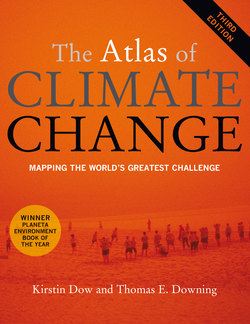Читать книгу The Atlas of Climate Change - Professor Kirstin Dow - Страница 19
На сайте Литреса книга снята с продажи.
ОглавлениеImpacts, vulnerability, and adaptation Climate change impacts are the consequences of natural and human systems. The impacts depend on the vulnerability of the system, in the climate change literature defined as a function of the character, magnitude, and rate of climate variation to which a system is exposed, its sensitivity, and its adaptive capacity. However, vulnerability has other common definitions. In disaster planning, risk is the outcome of vulnerability (social, economic and environmental exposure and sensitivity) and hazard (the probability and magnitude of an extreme event). In development planning and poverty assessment, vulnerability is described as exposure to multiple stresses, to shocks and to risk over a longer time period, with a sense of defencelessness and insecurity. Both impacts and vulnerability may be reduced by adaptation – adjustments in natural or human systems to a new or changing environment. Various types of adaptation can be distinguished, including anticipatory and reactive adaptation, private and public adaptation, and autonomous and planned adaptation. For people, adaptation can be seen as a process of social learning. Adaptive capacity is the ability to understand climate changes and hazards, to evaluate their consequences for vulnerable peoples, places and economies, and to moderate potential damages to take advantage of opportunities, or to cope with the consequences. Theory, prediction, forecasts, and scenarios A scientific theory is a coherent understanding of some aspect of our world, based on a well-established body of observations and interpretation. In popular culture, the label “theory” may be used in a derogatory manner to refer to propositions put forward to challenge a mainstream view. There is some confusion regarding how we view the future. In experimental language, we talk of predicted outcomes. So, a computer simulation of climate change predicts global warming, say of 3°C by 2100. This prediction depends on a set of underlying assumptions. A climate prediction is usually in the form of probabilities of climate variables such as temperature or precipitation, with lead times up to several seasons. The term climate projection is commonly used for longer-range predictions that have a higher degree of uncertainty and a lesser degree of specificity. For example, this term is often used to describe future climate change, which depends on the uncertain consequences of greenhouse gas emissions and land use change, in addition to the feedbacks within the atmosphere, oceans and land surface. It is extremely difficult to anticipate future greenhouse gas emissions. Countries may adopt stronger controls, industry and technology might reduce their carbon intensity, or consumers might rebel and ecological feedbacks might accelerate climate change. Where our understanding of the future is weak, we often use the term scenario: a plausible and often simplified description of how the future may develop, based on a coherent and internally consistent set of assumptions about key driving forces and relationships. Scenarios are neither predictions nor forecasts and sometimes may be based on a narrative storyline. Greenhouse gas emission scenarios To enable comparisons to be made between scenarios, in 1996 the IPCC issued its Special Report on Emissions Scenarios (SRES), which outlined a number of possible scenarios. These are now used by scientists to clarify the assumptions behind different emission pathways and the consequences for climate change. Scenario A1 represents a future world of very rapid economic growth, low population growth, and rapid introduction of more efficient technologies. Major underlying themes are economic and cultural convergence and capacity building, with a substantial reduction in regional differences in per capita income. The A1 scenario family develops into three alternative directions of technological change in the energy system: fossil-intensive (A1FI), non-fossil energy sources (A1T), or a balance across all sources (A1B). Scenario A2 portrays a very heterogeneous world. The underlying theme is that of strengthening regional cultural identities, with high population growth rates, and less concern for rapid economic development. Scenario B1 represents a convergent world with a global population that peaks in mid-century, rapid change in economic structures toward a service and information economy, with reductions in material intensity, and the introduction of clean and resource-efficient technologies. The emphasis is on global solutions to economic, social, and environmental sustainability, including improved equity, but without additional climate initiatives. Scenario B2 depicts a world in which the emphasis is on local solutions to economic, social, and environmental sustainability. It is a heterogeneous world with less rapid, and more diverse technological change than in A1 and B1. In 2010, the IPCC developed a scenario framework based on common profiles of greenhouse gas emissions, called Representative Concentration Pathways (RCPs). Climate results using these emissions scenarios will form the basis for the IPCC AR5.
19
